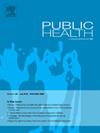常规细胞学检查计划:坚持与相关因素
IF 3.9
3区 医学
Q1 PUBLIC, ENVIRONMENTAL & OCCUPATIONAL HEALTH
引用次数: 0
摘要
研究设计重复测量观察性队列研究。方法从数据库中获取2018年1月至2022年12月期间筛查的临床和社会人口学数据。结果显示,坚持筛查的定义是根据国家指南接受 1、2 或 3 次细胞学检测。统计分析采用带稳健误差的泊松模型,以确定与坚持率相关的因素。结果共纳入 26445 名妇女,中位年龄为 25 岁(IQR:22-27)。依从率为 20.4%。仅受过高中教育(RR = 0.51;95% CI:0.49-0.55)、有怀孕史(RR = 0.63;95% CI:0.54-0.75)和有性传播感染史(RR = 0.88;95% CI:0.78-0.99)会降低坚持率。相反,人类乳头状瘤病毒(HPV)疫苗接种史会提高依从性(RR = 2.11;95% CI:1.60-2.80)。勤于随访,重点关注与依从性低有关的患者,同时进行预约提醒,可以提高筛查方案的依从性。本文章由计算机程序翻译,如有差异,请以英文原文为准。
Conventional cytology scheme: adherence and associated factors
Objectives
This study analyzed adherence rates to conventional cytology and associated factors in a cohort of women at a health service provider institution in Medellin, Colombia.
Study design
Observational cohort study with repeated measures.
Methods
Clinical and sociodemographic data were obtained from databases for screenings between January 2018 and December 2022. Adherence, defined as undergoing 1, 2, or 3 cytology tests according to national guidelines, was the outcome. Statistical analysis involved a Poisson model with robust errors to identify factors associated with adherence.
Results
In total, 26,445 women were included, with a median age of 25 years (IQR: 22–27). Adherence rate was 20.4%. Having just high school education (RR = 0.51; 95% CI: 0.49–0.55), a history of pregnancy (RR = 0.63; 95% CI: 0.54–0.75), and a history of sexually transmitted infections (RR = 0.88; 95% CI: 0.78–0.99) decreased adherence. Conversely, the human papillomavirus (HPV) vaccination history increased adherence (RR = 2.11; 95% CI: 1.60–2.80).
Conclusion
It is vital to monitor cytology programs to improve demand-induced and spontaneous consultations. Diligent follow-up, focusing on patients with factors linked to low adherence, along with appointment reminders, can enhance adherence to the screening protocol.
求助全文
通过发布文献求助,成功后即可免费获取论文全文。
去求助
来源期刊

Public Health
医学-公共卫生、环境卫生与职业卫生
CiteScore
7.60
自引率
0.00%
发文量
280
审稿时长
37 days
期刊介绍:
Public Health is an international, multidisciplinary peer-reviewed journal. It publishes original papers, reviews and short reports on all aspects of the science, philosophy, and practice of public health.
 求助内容:
求助内容: 应助结果提醒方式:
应助结果提醒方式:


